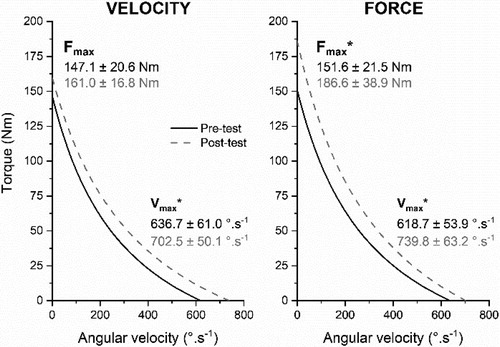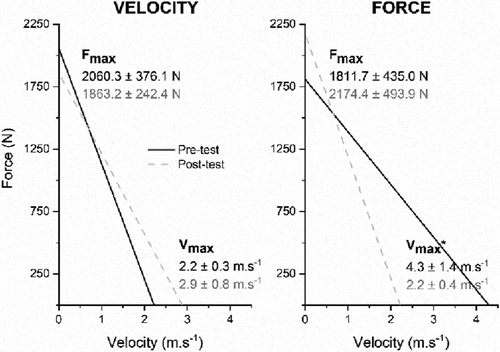1. Introduction
In many sports, the performance depends on the capacity to produce high level of force at different velocity level. To evaluate this capacity, force-velocity relationships have been used at the joint level or during sport movements (jump, sprint, cycling…) (Samozino et al. Citation2008, Morin et al. Citation2012, Dorel et al. Citation2010). Several authors have investigated the evolution of force-velocity relationships following a training protocol. Duchateau and Hainaut (Citation1984) showed that an isometric training of the adductor pollicis improved the force component of the relationship while a dynamic training improved the velocity component. Cormie et al (Citation2010) have investigated the effect of force versus ballistic jump training on the squat jump force-velocity relationship. They also showed a training stimulus effect on the force-velocity relationship. Force-oriented training improved the force component while velocity-oriented training improved the velocity component of the relationship. These studies have investigated the effect of training at one joint level or in one type of exercise and their effects on the corresponding movement. To our knowledge the effect of training a muscle group at one joint level (e.g. ankle) and their repercussion on a plurisegmental movement (e.g. jump) has not been investigated. Thus, the aim of this study was to investigate the effect of a 12 weeks training protocol (force vs. velocity) of the plantar flexor muscles on the plantar flexion torque-angular velocity relationship and the squat jump force-velocity relationship.
2. Methods
2.1. Participants
Twenty-two male were included in this study. They were randomly separated in two training groups.
In the first group, 11 participants (age: 24.9 ± 3.9 years, height: 178.2 ± 4.9 cm, mass: 73.5 ± 7.7 kg) underwent a velocity-oriented training of the plantar flexor muscles. In the second group the training of the 11 participants (age: 24.4 ± 2.8 years, height: 177.3 ± 4.9 cm, mass: 73.0 ± 5,6 kg) was oriented toward force capacity.
2.2. Pre- and post-test evaluations
Torque-angular velocity relationship of the plantar flexor muscle group was evaluated before and after the training period as well as the force-velocity profile in squat jump.
The plantar flexion torque-angular velocity relationship was evaluated in isokinetic conditions on an Eracles ergometer (Eracles technology, Compiegne, France) at 0 (isometric), 30, 120, 210 and 300°/s. High-velocity plantar flexions were performed on a specific ergometer composed of a rotational footplate and a bench (Bio2M, Compiègne, France). The three isoinertial conditions tested were 0 kg, 1.5 kg and 3 kg applied to the back of the pedal. The squat jump force-velocity profile was evaluated on a force-platform with incremental additional loads. Five conditions were tested. Loads were selected accordingly with the performance on the previous trial.
2.3. Training protocol
Both training groups trained for 12 weeks. The force group realized 24 training sessions of 10 isometric contractions of 5 s and 6 training sessions of 5 series of 5 maximal isokinetic repetitions at 30°/s. The velocity group realized 24 training sessions of 10 series of 10 ballistic repetitions with no additional load and 6 training sessions of 10 series of 10 ballistic repetitions with a 3 kg load.
2.4. Data processing and statistical analysis
The plantar flexors torque-angular velocity relationship was fitted using the equation proposed by Hill in 1938. The squat jump force-velocity profile was fitted using a linear equation. The maximal theoretical velocities were considered as the torque-angular velocity and force-velocity x-intercepts (Vmax) and the maximal theoretical torque and force as the y-intercepts (Fmax).
As data were normally distributed, we performed student t-test to compare pre- and post-Vmax and Fmax.
3. Results and discussion
The plantar flexors torque-angular velocity relationships pre- and post-training are presented in . The squat jump force-velocity relationships pre- and post-training are presented in . Vmax and Fmax values are presented as mean ± standard deviation in both figures.
Figure 1. Plantar flexors torque-angular velocity relationship pre- and post-training for the velocity training group (left panel) and force training group (right panel). * significantly different (P < 0.05) between pre-and post-tests.

Figure 2. Squat jump force-velocity relationships pre- and post-training for the velocity training group (left panel) and force training group (right panel). *significantly different (P < 0.05) between pre- and post-tests.

For the velocity group, Vmax significantly (P < 0.05) increased (+15.7%) between pre- and post-test while no significant differences were observed for Fmax (P = 0.06). For the force group, both Vmax and Fmax significantly (P < 0.05) increased (+9,2% and +16.9% respectively) between pre- and post-tests.
No significant differences were observed between pre- and post-tests for Fmax and Vmax in the velocity group. In the force group, Fmax was not significantly different between pre- and post-tests while Vmax significantly decrease in post-tests (P < 0.05).
4. Conclusions
As previously described by Duchateau and Hainaut (Citation1984) showed that, at a joint level, a force-oriented training protocol improved the force component of the torque-angular velocity relationship while a velocity-oriented training improved the velocity component of the relationship. However, these improvements observed at the ankle level were not extended to the squat jump force-velocity relationship.
Further investigations are needed to describe the effects of such training protocols on the plantar flexors muscle-tendon interactions. Moreover, while no significant differences in squat jump force-velocity relationships were observed in this study, the influence of training only one muscle group on the evolution of muscle coordination during a global performance (i.e. jump) remains to be investigated.
Acknowledgements
We thank the participants for their involvement in the experiment.
References
- Cormie P, McGuigan MR, Newton RU. 2010. Adaptations in athletic performance following ballistic power vs strength training. Med Sci Sport Exer. 2(8):1582–1598.
- Dorel S, Couturier A, Lacour JR, Vandewalle H, Hautier C, Hug F. 2010. Force-velocity relationship in cycling revisited: benefit of two-dimensional pedal forces analysis. Med Sci Sports Exerc. 42(6):1174–1183.
- Duchateau J, Hainaut K. 1984. Isometric or dynamic training: differential effects on mechanical properties of a human muscle. J Appl Physiol Respir Environ Exerc Physiol. 56(2):296301.
- Morin JB, Bourdin M, Edouard P, Peyrot N, Samozino P, Lacour JR. 2012. Mechanical determinants of 100-m sprint running performance. Eur J Appl Physiol. 112(11):3921–3930.
- Samozino P, Morin JB, Hintzy F, Belli A. 2008. A simple method for measuring force, velocity and power output during squat jump. J Biomech. 41(14):2940–2945.
